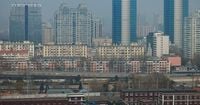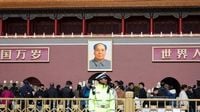China’s Communist Party has unveiled the broad contours of its next five-year economic plan, signaling a determined push for technological self-reliance and a modern industrial system as the country faces mounting pressures from abroad and at home. The announcement, delivered in a communique after a four-day closed-door meeting of the Party’s Central Committee in Beijing on October 23, 2025, underlines the leadership’s intent to fortify the nation’s position in its intensifying rivalry with the United States and to shore up its economic resilience for the years ahead.
According to Xinhua, China’s state-run news agency, the 2026-2030 plan will focus on “greatly increasing” the country’s capacity for self-reliance and strength in science and technology. This emphasis comes as the U.S. government, under President Donald Trump, has tightened controls on the export of semiconductors and other high-tech goods to China, seeking to limit Beijing’s access to critical technologies. The communique did not directly mention the ongoing trade war, but the context was unmistakable. China, it said, faces “profound and complex” changes, along with rising uncertainty and unpredictable factors in the years to come.
The Party’s message was clear: China must accelerate efforts to reduce its dependence on foreign technology and supply chains. “Building a modern industrial system with advanced manufacturing as the backbone” and “accelerating high-level scientific and technological self-reliance” were listed ahead of the development of a strong domestic market, the communique showed, as reported by Reuters. The leadership also pledged to expand domestic demand and improve people’s livelihoods—long-standing goals that have often been overshadowed by the country’s focus on manufacturing and investment.
Yet the plan’s details remain sparse. The full five-year blueprint will not be released until March 2026, when China’s legislature is expected to give it a rubber-stamp approval at its annual meeting. For now, the outline signals more continuity than change, echoing the policy direction set out by President Xi Jinping in recent years. “The general impression of the communique is that it highlights much more continuity than change,” said Xin Sun, a senior lecturer in Chinese and East Asian Business at King’s College London, as quoted by Associated Press. “It means China will likely demand more from the U.S. to reach a deal, if one is to be reached,” added Gary Ng, a senior economist at Natixis, a French investment bank.
China’s industrial policy has already propelled the rapid development of sectors like electric vehicles, wind and solar power, and more recently, robotics and artificial intelligence. The country boasts sophisticated domestic supply chains and a near-monopoly in rare earth production, which are indispensable to global defense and semiconductor industries. These achievements have given Beijing confidence as it navigates trade tensions with Washington and seeks to bolster its negotiating position in upcoming talks between Xi Jinping and Donald Trump in South Korea, scheduled for next week.
Despite these strengths, the Party’s communique acknowledged the challenges ahead. China’s economic growth slowed to its weakest pace in a year in the third quarter of 2025, with the economy expanding by 4.8% in the July-to-September period. The government, however, remains confident that it is on “solid foundation” to achieve its full-year growth target of around 5%. Still, economists warn that China’s growth model is under strain from high debt levels—now roughly three times the size of the economy—and persistent low inflation. “The main risk here is the coexistence of high debt and low inflation,” said Dan Wang, China director at Eurasia Group, calling the model “very fragile.”
Another unresolved tension lies in the leadership’s stated desire to boost household consumption while maintaining manufacturing’s central role. “There is still an unresolved tension between the leadership’s purported desire to boost consumption and its goal of shoring up the size of its manufacturing sector,” said Julian Evans-Pritchard, an analyst at Capital Economics. “The leadership will have to choose one or the other. Today’s communique leaves little doubt over which way they are leaning.”
To encourage domestic demand, Beijing has rolled out policies such as subsidies for consumer loans and child care, and trade-in programs for electric vehicles and appliances. However, low wages, feeble social welfare benefits, and limited worker confidence continue to suppress household spending. The communique promised to “improve people’s welfare and the social security system” but did not specify how these objectives would be achieved or funded, leaving economists and investors uncertain about the government’s ability to rebalance the economy.
Beyond the economic agenda, the Central Committee meeting was notable for its sweeping personnel changes. The Party replaced 11 members of its Central Committee—the highest turnover since 2017—amid an ongoing anti-corruption purge within the military. General Zhang Shengmin, 67, was promoted to second-ranked vice chair of the powerful Central Military Commission, replacing He Weidong, who was expelled from the Communist Party on corruption charges along with eight other senior People’s Liberation Army generals. Zhang, already a member of the commission and secretary of its Discipline and Inspection Commission, now holds a pivotal role in Xi Jinping’s campaign to modernize China’s military and ensure political loyalty.
The removal of He Weidong, a former close confidant of Xi, marks the first time a sitting general on the Central Military Commission has been ousted since the Cultural Revolution. The ongoing anti-corruption campaign, launched by Xi after he came to power in 2012, has targeted both the Party and the government, seeking to root out graft at all levels. The high turnover at the Central Committee meeting underscores the leadership’s resolve to maintain discipline and control within the upper echelons of power.
As China looks ahead to the next five years, the Party’s priorities are unmistakable: fortifying its technological base, safeguarding its industrial might, and navigating an increasingly uncertain global environment. The coming months will reveal whether Beijing can deliver on its promises to boost domestic demand and improve livelihoods, or whether the familiar emphasis on manufacturing and state-led investment will continue to dominate. For now, the world watches as China charts its course through a period of both strategic opportunity and risk, determined to secure its future on its own terms.


